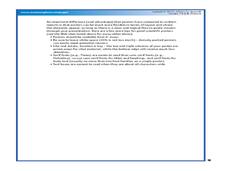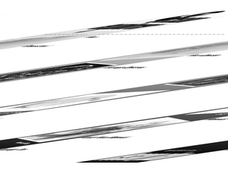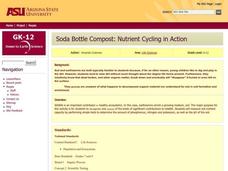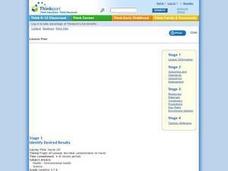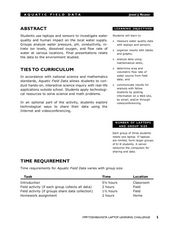Curated OER
Estimating With Fractions
Seventh graders, exploring methods to estimate fractions, take notes on estimating fractions, 7th graders write letters to explain the process of estimating fractions and mixed numbers to someone who does not know the concept. Students...
Curated OER
Let's Hit the Slopes!
Learners study benthic communities in the Gulf of Mexico and explain their roles. In this investigative instructional activity students participate in a group activity and study how to calculate and index of biological...
Curated OER
Where's the Oxygen?
High schoolers study seawater and how temperature and salinity influence it. In this oxygen lesson students complete a lab activity on dissolved oxygen.
Curated OER
What's So Special?
Students study the biology and morphology of Lophelia corals. In this investigative lesson students explain how the coral contributes to communities, and create a poster.
Curated OER
Distant Relatives
Pupils investigate observations between widely separated populations of anchialine cave fauna. In this biogeography lesson students discuss theories that could explain the given observations.
Curated OER
To See or Not to See
Students identify and discuss key factors that determine how effective color camouflage is in certain habitats. In this investigative lesson students divide into groups and study light.
Curated OER
Aging of Trees
Students examine tree rings to determine its age. In this tree ring lesson, students examine core tree samples, identify the tree rings, and then determine its age. Students complete a worksheet, deciding which of the two core...
Curated OER
Observation Hike
Students participate in an observational hike to study the natural surroundings. In this observational hike lesson, students hike through a state park and observe the plant and animal life. Students learn about appropriate...
Curated OER
Botanical Discoveries
Sixth graders study the chronology of major events of the Lewis and Clark Expedition. They use primary and secondary resources to obtain information about the plants which were identified by Lewis and Clark.
Curated OER
Soda Bottle Compost: Nutrient Cycling in Action
Young scholars investigate, through their own experimentation, the important role wildlife play in nutrient cycling. Earthworms and compost are used in this experiment and different experimental setups be evaluated.
Curated OER
How Do We Generate a Large Amount of a Specific DNA Sample?
High schoolers investigate the Polymerase Chain Reaction technique that is used to create larger amounts of a gene. They watch and discuss a PowerPoint presentation, explore a website, and write a report listing the materials needed to...
Curated OER
Echolocation Lab
High schoolers explore echolocation of animals. They examine how dolphins and other echolocating animals use their senses to locate and identify objects without using their sense of sight. Through experimentation, they discover how sound...
Curated OER
Warm and Toasty
Students are introduced to the concepts of specific heat and heat capacity. In groups, they design an experiment to test these two topics on various fabrics. They compare and contrast the amount of heat loss on the different materials...
Curated OER
An Introduction to Simple Machines
Students investigate simple machines and their uses in everyday life. In this scientific method lesson, students examine physical tools such as wedges, screws, and levers using a "how does it work" approach. Students complete...
Curated OER
Archery
Pupils study archery. In this archery lesson, students develop basic archery and hunter safety skills. Pupils discuss the history of archery and bow hunting.
Curated OER
Canoe and Kayak
Students explore canoes and kayaks. In this canoe and kayak lesson, students research the history, parts, and sport of the canoe and kayak. Students then practice how to use a paddle for each boat, and go on a field trip in order...
Curated OER
Looking into the Past (Archaeology)
Students discover how to be an archaeologist. In this archaeology lesson, students research the basic information about an archaeologist. Students then observe different artifacts and learn what questions to ask in order to discover the...
Curated OER
Special Place
Students observe and describe a "special place" chosen along a nature trail. In this habitat observational skills and writing lesson, students take a walk on a nature trail and choose a spot to sit and meditate. Students complete a...
Curated OER
Oh, Say Can You See
Students explore different parts of the eye and functions of each part through a video and a dissection of a cow's eye. They discover different causes of blindness.
Curated OER
Hands Off
Pupils perform a handwashing experiment to see if a difference can be detected in the number and types of microbes on our hands after various types of cleaning. They will also demonstrate that they have learned the whys and hows of good...
Curated OER
Aquatic Field Data
Students use laptops and sensors to measure water quality and graph their results. In this aquatics lesson students post their results to a website or email.
Curated OER
Carmaleetas
Students identify the relationship between predator and prey in the food chain. In this food chain lesson, students work in groups and play a predator and prey game. Students discover what happens when a predator does not find prey.
Curated OER
Edible Wild Plants
Students explore the benefits of recognizing edible wild plants. In this wild plant lesson, students collect, make ready and eat edible plants. Students answer questions about the plants.
Curated OER
Is There A Fungus Among Us?
Sixth graders classify fungus into two different groups. In this fungus lesson, 6th graders collect as many pieces of fungus as possible. Students then classify these pieces of fungus as saprophytic or parasitic.
Other popular searches
- Life Science Inquiry Fossils
- Life Science Inquiry Frogs
- Life Science Inquiry Lessons
- Life Science Inquiry Labs
- Life Science Inquiry Mammals
- Life Science Inquiry Chicken
- Inquiry Based Life Science





